By Dr. Ileana Johnson Paugh ——Bio and Archives--September 23, 2011
Cover Story | CFP Comments | Reader Friendly | Subscribe | Email Us
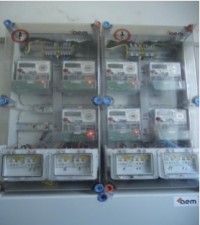 As we made our way through the southeastern and central Romania, the common theme of high- rise tenements with shops on the first floor emerged. Some were left from Ceausescu’s communist era; some were built after the 1989 revolution with specifications and money from EU. I could tell the difference between Ceausescu's tenements and the newer ones; the older tenements were not as tall and were more dilapidated. Many people purchased these tiny apartments and remodeled them on the inside, while waiting for non-existent government help to fix the exterior, just like the communist nanny state used to do. The newer tenements were much taller and in better exterior condition.
As we made our way through the southeastern and central Romania, the common theme of high- rise tenements with shops on the first floor emerged. Some were left from Ceausescu’s communist era; some were built after the 1989 revolution with specifications and money from EU. I could tell the difference between Ceausescu's tenements and the newer ones; the older tenements were not as tall and were more dilapidated. Many people purchased these tiny apartments and remodeled them on the inside, while waiting for non-existent government help to fix the exterior, just like the communist nanny state used to do. The newer tenements were much taller and in better exterior condition. Some tenements had A/C window units, some had thermo pane windows as prescribed by EU, and others had clothes hanging out to dry, a sign that electricity and modern conveniences were still quite expensive.
Some tenements had A/C window units, some had thermo pane windows as prescribed by EU, and others had clothes hanging out to dry, a sign that electricity and modern conveniences were still quite expensive.
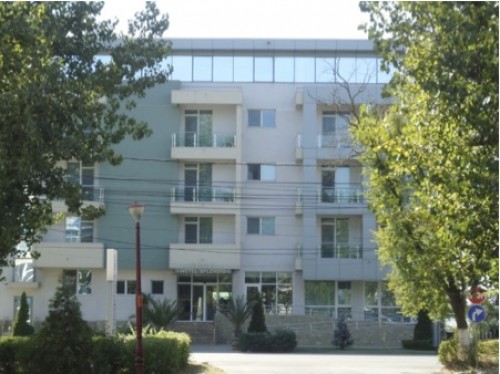 When I drove by the old tenement where we used to live on the fifth floor, I was amazed that it was still standing. The cracks from the 1977 earthquake had been repaired and nothing else. I photographed our former apartment as my husband was remarking how tiny it was. I was shocked how little things changed in 33 years since I last lived in it.
When I drove by the old tenement where we used to live on the fifth floor, I was amazed that it was still standing. The cracks from the 1977 earthquake had been repaired and nothing else. I photographed our former apartment as my husband was remarking how tiny it was. I was shocked how little things changed in 33 years since I last lived in it.
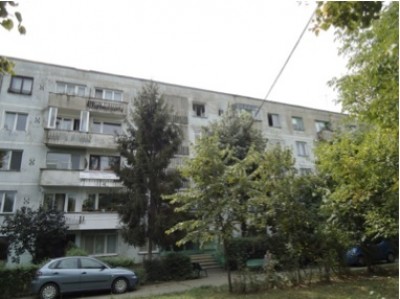 The town of Brasov in central Romania, with a more progressive populace, was offering a “green revolution” free bike sharing program downtown where a large area was blocked off to traffic and many streets were one-way, encouraging drivers to park as far away from the center of town as possible.
The town of Brasov in central Romania, with a more progressive populace, was offering a “green revolution” free bike sharing program downtown where a large area was blocked off to traffic and many streets were one-way, encouraging drivers to park as far away from the center of town as possible.
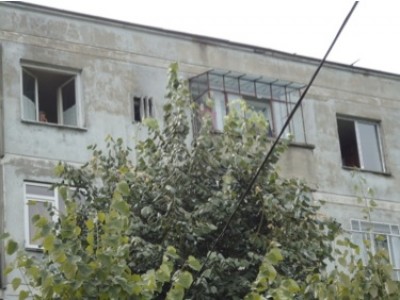
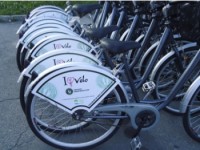 “I love Velo,” the free bike sharing program was sponsored by the Green Revolution, Inc. from Connecticut and Raiffeisen Bank and started in Bucuresti on May 9, 2011. If there is any doubt about the connection to Agenda 21, the mission says it all, “At the Green Revolution, our mission is to involve people in the process of creating clean renewable energy from everyday, human activity that will result in sustainable behavior change and lower energy costs.”
A co-operative bank based and founded in Austria and operating throughout central and Eastern Europe, Raiffeisen was a reference to Friedrich Wilhelm Raiffeisen, the founder of the co-operative movement and of credit unions.
After communism fell, most agricultural co-operatives failed and the land was sold to different investors and entrepreneurs, piece by piece, by various former peasant owners who had been displaced off the land into urban tenements.
People who chose not to sell, are farming their own land, renting it out to larger farmers, or are selling to foreigners who want to develop it or return it to its wilderness state.
I was amazed how unconcerned young people were that a lot of their food came from exports from China and Turkey while some of their agricultural land was being left unfarmed. I witnessed huge parcels in Baragan, a former breadbasket of the Balkans, which now appeared for miles and miles like a dust bowl with dust funnels forming here and there. Without roots to hold it down, soil was being eroded by wind gusts.
“I love Velo,” the free bike sharing program was sponsored by the Green Revolution, Inc. from Connecticut and Raiffeisen Bank and started in Bucuresti on May 9, 2011. If there is any doubt about the connection to Agenda 21, the mission says it all, “At the Green Revolution, our mission is to involve people in the process of creating clean renewable energy from everyday, human activity that will result in sustainable behavior change and lower energy costs.”
A co-operative bank based and founded in Austria and operating throughout central and Eastern Europe, Raiffeisen was a reference to Friedrich Wilhelm Raiffeisen, the founder of the co-operative movement and of credit unions.
After communism fell, most agricultural co-operatives failed and the land was sold to different investors and entrepreneurs, piece by piece, by various former peasant owners who had been displaced off the land into urban tenements.
People who chose not to sell, are farming their own land, renting it out to larger farmers, or are selling to foreigners who want to develop it or return it to its wilderness state.
I was amazed how unconcerned young people were that a lot of their food came from exports from China and Turkey while some of their agricultural land was being left unfarmed. I witnessed huge parcels in Baragan, a former breadbasket of the Balkans, which now appeared for miles and miles like a dust bowl with dust funnels forming here and there. Without roots to hold it down, soil was being eroded by wind gusts.
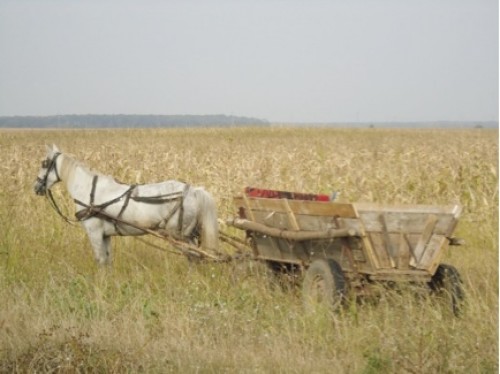 I saw large parcels of corn being harvested with prison labor. I am not sure who owned the land, whether it was legal to use prisoners, or whether they were hard-core criminals or just petty thieves paying damages through their work. The harvest, as well as everything on the farm, within the village community was transported by horse and buggy because gasoline and Diesel were so expensive. Cars were often parked at home during the week, driven for weekend trips, while the owners took public transportation to work.
I saw large parcels of corn being harvested with prison labor. I am not sure who owned the land, whether it was legal to use prisoners, or whether they were hard-core criminals or just petty thieves paying damages through their work. The harvest, as well as everything on the farm, within the village community was transported by horse and buggy because gasoline and Diesel were so expensive. Cars were often parked at home during the week, driven for weekend trips, while the owners took public transportation to work.
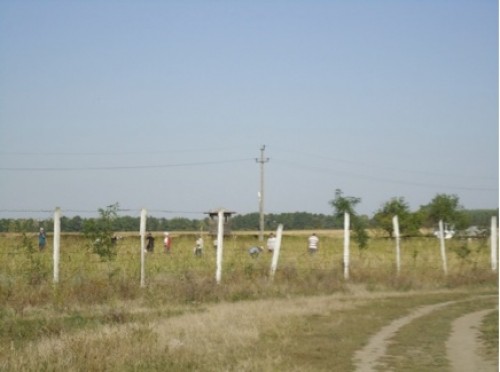 In their rush to development, some gas meters were improperly installed; gas leak alarms were neglected, resulting in catastrophic explosions such as this one.
In their rush to development, some gas meters were improperly installed; gas leak alarms were neglected, resulting in catastrophic explosions such as this one.
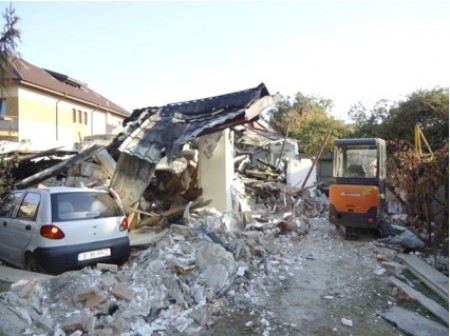 When the sun went down, the environment was plunged into darkness, some places dimly lit by one anemic light, of the CFL variety. The museums we saw had one bulb per room, the displays were dark and impossible to read, covered in dust and forgotten. It was a perfect scenario for stargazing since ambient light was non-existent in many areas.
When the sun went down, the environment was plunged into darkness, some places dimly lit by one anemic light, of the CFL variety. The museums we saw had one bulb per room, the displays were dark and impossible to read, covered in dust and forgotten. It was a perfect scenario for stargazing since ambient light was non-existent in many areas.
 As we made our way to Constanta and the Black Sea, I was appalled to see many historical buildings abandoned, rusting, with peeling walls, and overgrown with weeds. A precious Etruscan sarcophagus, exhibited outdoors, was serving as a makeshift trash bin.
As we made our way to Constanta and the Black Sea, I was appalled to see many historical buildings abandoned, rusting, with peeling walls, and overgrown with weeds. A precious Etruscan sarcophagus, exhibited outdoors, was serving as a makeshift trash bin.
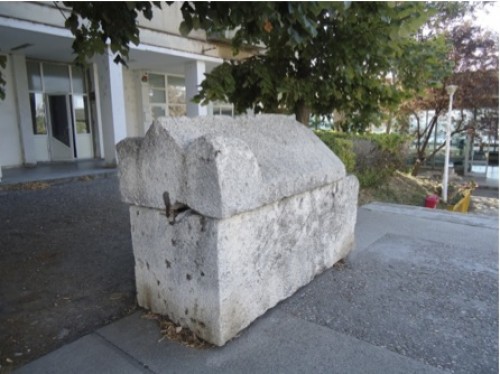 The very precious statues from Cernavoda, the “Thinker and his Companion,” 5,000 B.C., that appear in every school textbook in the world, were abandoned in a dark corner, gathering dust in the Tomis Museum.
The very precious statues from Cernavoda, the “Thinker and his Companion,” 5,000 B.C., that appear in every school textbook in the world, were abandoned in a dark corner, gathering dust in the Tomis Museum.
 I could not understand the abandonment of history, of identifying with one’s heritage. As I explored further, I was told that education, keeping in line with the Agenda 21 goal of building a one world government without national identity and sovereignty, has discouraged the study and preservation of history, of who Romanians are, where they have come from and, in the process, anything of historical significance had been abandoned unless it brought a lot of cash to the ruling coalition parties. Generous grants were given to further the study of environmental preservation, green revolution, alternative energy sources such as windmills, and population control.
We visited three museums in my hometown of Ploiesti. We were the only visitors. I was thinking how busy our Smithsonian museums were on any given day in Washington, D.C., bustling with noisy children on school trips and it gave me hope that Americans are still proud of who they are and where they have come from.
Hundreds of windmills were dotting the Baragan fields in the south, some barely moving, most completely stopped. I wondered how much electricity these expensive windmills actually generated to justify the huge infrastructure investment paid for by European Union grants and loans.
As I spoke with relatives, none of whom knew of UN Agenda 21, I was told unanimously that Romanians would never agree to give up their private property and liberties in the name of saving the environment that does not need saving to begin with, carbon credits, and other UN schemes. Besides, people had just gotten back their properties that were stolen by communists. Yet, in spite of their optimism, signs of Agenda 21 in progress were everywhere
I saw “For Sale” signs for land that was under litigation. Nobody wanted to buy land under litigation since the owners had not been definitively decided. Just like our housing market bubble, when it burst, nobody knew who owned many homes. Banks could not find the paperwork to sell them.
These citizens, ignorant of UN Agenda 21 and its goals, mirrored most Americans who are equally incredulous and believe that we are wearing tinfoil hats when we speak about UN Agenda 21’s nefarious intent.
On our drive back from the Black Sea, we passed by the Romanian Nuclear Power Plant at Cernavoda. No photographs signs were everywhere. The rusty exterior in bad need of a paint job did not inspire confidence in its solidity. I urged my husband to drive by faster.
I could not understand the abandonment of history, of identifying with one’s heritage. As I explored further, I was told that education, keeping in line with the Agenda 21 goal of building a one world government without national identity and sovereignty, has discouraged the study and preservation of history, of who Romanians are, where they have come from and, in the process, anything of historical significance had been abandoned unless it brought a lot of cash to the ruling coalition parties. Generous grants were given to further the study of environmental preservation, green revolution, alternative energy sources such as windmills, and population control.
We visited three museums in my hometown of Ploiesti. We were the only visitors. I was thinking how busy our Smithsonian museums were on any given day in Washington, D.C., bustling with noisy children on school trips and it gave me hope that Americans are still proud of who they are and where they have come from.
Hundreds of windmills were dotting the Baragan fields in the south, some barely moving, most completely stopped. I wondered how much electricity these expensive windmills actually generated to justify the huge infrastructure investment paid for by European Union grants and loans.
As I spoke with relatives, none of whom knew of UN Agenda 21, I was told unanimously that Romanians would never agree to give up their private property and liberties in the name of saving the environment that does not need saving to begin with, carbon credits, and other UN schemes. Besides, people had just gotten back their properties that were stolen by communists. Yet, in spite of their optimism, signs of Agenda 21 in progress were everywhere
I saw “For Sale” signs for land that was under litigation. Nobody wanted to buy land under litigation since the owners had not been definitively decided. Just like our housing market bubble, when it burst, nobody knew who owned many homes. Banks could not find the paperwork to sell them.
These citizens, ignorant of UN Agenda 21 and its goals, mirrored most Americans who are equally incredulous and believe that we are wearing tinfoil hats when we speak about UN Agenda 21’s nefarious intent.
On our drive back from the Black Sea, we passed by the Romanian Nuclear Power Plant at Cernavoda. No photographs signs were everywhere. The rusty exterior in bad need of a paint job did not inspire confidence in its solidity. I urged my husband to drive by faster.View Comments
Dr. Ileana Johnson Paugh, Ileana Writes is a freelance writer, author, radio commentator, and speaker. Her books, “Echoes of Communism”, “Liberty on Life Support” and “U.N. Agenda 21: Environmental Piracy,” “Communism 2.0: 25 Years Later” are available at Amazon in paperback and Kindle.